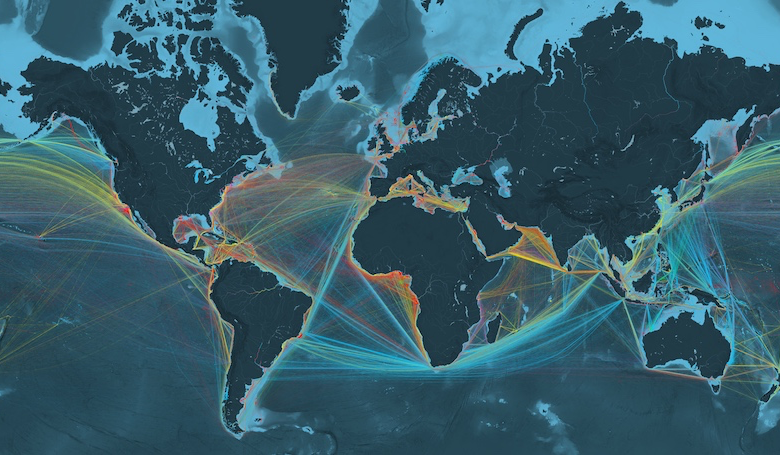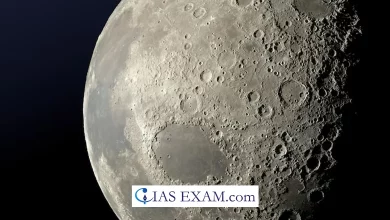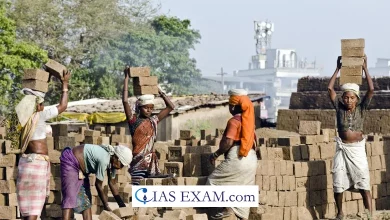Daily Current Affairs for UPSC
Disruptions to Global Trade Sea Routes
Syllabus- Economy (GS Paper-3)

Context- The United Nations Conference on Trade and Development (UNCTAD) has raised concerns on escalating disruptions to global trade due to the geopolitical tensions and climate change affecting the world’s key trade routes.
Waterways
- Waterways are the most appropriate and cheapest for international trade.
- International trade is completed through ports and harbours which are linked with hinterlands via railways, roads or inland waterways.
- It may be categorized as countrywide and global transportation.
- The water transport may be divided into two components: Inland water transport and Ocean water transport.
Major Choke Points in International Trade Sea Route
- Strait of Hormuz: Located between the Persian Gulf and the Gulf of Oman, the Strait of Hormuz is a crucial passage for oil shipments from the Middle East.
- A big part of the world’s oil supply passes through this choke point.
- Malacca Strait: Located between the Malay Peninsula and the Indonesian island of Sumatra, the Malacca Strait is one of the busiest waterways globally.
- It connects the Indian Ocean to the South China Sea and the Pacific Ocean, making it a key route for change among Europe, the Middle East, and East Asia.
- Suez Canal: Connecting the Mediterranean Sea to the Red Sea, the Suez Canal is a critical shortcut for ships traveling among Europe and Asia.
- It drastically reduces the journey distance and time in comparison to the opportunity route around the southern tip of Africa.
- Panama Canal: Linking the Atlantic and Pacific Oceans, the Panama Canal is critical for maritime change between the Americas, Europe, and Asia.
- It allows ships to bypass the lengthy and treacherous journey across the southern tip of South America.
- Taiwan Strait: Separating Taiwan from mainland China, the Taiwan Strait is important for transport in the East Asian area. It is a heavily trafficked waterway for items transferring among China, Taiwan, Japan, and different Asian international locations.
Disruptions on Trade Routes
- Suez Canal: UNCTAD estimates that the weekly transits going through the Suez Canal reduced by forty 2% over the past months.
- About 12 percent of global trade passes through the Suez Canal.
- Ships are actually being forced to take the Cape of Good Hope course, which includes circumnavigating the whole African continent, it is now taking them 37–41 days to attain their destination in comparison to 27 days through Suez Canal.
- Panama Canal: Simultaneously, the Panama Canal, a pivotal conduit for worldwide trade, is grappling with dwindled water stages, resulting in an amazing 36% reduction in overall transits over the last month compared to a year ago.
- The Panama Canal accounts for 6 percent of world trade.
- A vessel taking the Cape Horn direction, in preference to the Panama Canal, takes 18 extra days of journey time.
- The crisis within the Red Sea, marked through Houthi-led assaults disrupting delivery routes, has delivered another layer of complexity.
Implications
- Increase in Trade Cost: The cumulative effect of those disruptions translates into extended shipment tour distances, escalating exchange prices, and a surge in greenhouse gas emissions from shipping having to travel greater distances and at greater speed.
- Avoiding the Suez and Panama Canal necessitates more days of delivery, resulting in extended charges.
- Environmental Concerns: Additionally, ships are pressured to journey quicker to atone for detours, burning more gas consistent with miles and emitting more CO2, similarly exacerbating environmental concerns.
- Increases in Food and Energy Prices: Prolonged interruptions, particularly in container transport, pose an instantaneous hazard to worldwide supply chains, doubtlessly leading to delayed deliveries and heightened fees.
- Energy prices are witnessing a surge as gas transits are discontinued, directly impacting power materials, mainly in Europe.
- Impact on developing countries: Developing nations are especially vulnerable to these disruptions.
Way Ahead
- The company emphasizes the pressing need for swift adaptations from the delivery enterprise and strong international cooperation to navigate the speedy reshaping of global trade dynamics.
- The present day demanding situations underscore trade’s vulnerability to geopolitical tensions and climate-related demanding situations, demanding collective efforts for sustainable solutions especially in support of countries more vulnerable to these shocks.
Source: The Hindu
Practice question:
- What geopolitical factors contribute to choke points in sea routes?





.png)



